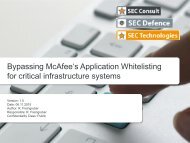1401-Baywatch
1401-Baywatch
1401-Baywatch
You also want an ePaper? Increase the reach of your titles
YUMPU automatically turns print PDFs into web optimized ePapers that Google loves.
J. Poort et al. / Telecommunications Policy ] (]]]]) ]]]–]]] 9<br />
downloading from illegal sources, possibly in favour of legal channels. Two complementary empirical methods (yielding five<br />
measurements) for assessing the effects of this intervention on downloading from illegal sources are presented in the paper.<br />
No strong indications are found for any structural effects.<br />
Two consecutive consumer surveys provide insight into consumers 0 reactions to the intervention after three, six and ten<br />
months, as well as the reaction they expect shortly before blocking. The intervention can only affect consumers who<br />
download or intend to download from illegal sources, 27–28% over the past year. For this segment of the population, it is<br />
found that a large majority (70–72%) is non-responsive to blocking access to TPB. This is significantly more than consumers<br />
expect prior to the blocking. About half of those who report a response to the intervention state they download less, while a<br />
third state they stopped downloading altogether. The rest claim to download more as a result of the intervention.<br />
This would suggest a small negative blocking effect of the intervention on the percentage of the population downloading<br />
from illegal sources. However, no such effect is found. Instead, the percentage downloading films & series, games and books<br />
from illegal sources in the preceding six months increased between May and November/December 2012, while downloading<br />
music from illegal sources remained constant. This implies that any behavioural change in response to blocking<br />
access to TPB has had no lasting net impact on the overall number of downloaders from illegal sources, as new consumers<br />
have started downloading from illegal sources and people learn to circumvent the blocking while new illegal sources may be<br />
launched, causing file sharing to increase again (relapse effect).<br />
These findings are corroborated by the second, complementary method presented: BitTorrent monitoring. BitTorrent<br />
monitoring measures observed rather than reported behaviour, but with the short-coming that it cannot observe consumers<br />
circumventing the blocking by downloading via VPN connections or from newsgroups and cyberlockers. BitTorrent<br />
monitoring reveals only small changes in the distribution of Dutch peers over the different ISPs for the three measurements,<br />
which implies very limited effects of the intervention on BitTorrent file sharing.<br />
For the small changes observed, it is not fully possible to disentangle the different and opposing effects of the blocking<br />
itself, awareness of the intervention, conversion to legal alternatives induced by the blocking, and a relapse as a result of<br />
circumvention or the launch of new file sharing platforms. The fact that consumers report a significantly smaller response to<br />
the intervention than they expect in advance, indicates that the awareness effect wears off quickly. Furthermore, the increase<br />
between the two surveys of the percentage of ISP subscribers admitting to having downloaded from illegal sources in the<br />
preceding period indicate a relapse effect: After a small initial awareness or blocking effect, the market moves back towards<br />
the earlier equilibrium, with no or only very small structural effects.<br />
These results are in line with a tendency found in the literature that any effects of legal action against file sharing often<br />
fade out after a period of typically six months, as the initial awareness effect wears off and illegal supply and demand find<br />
other places to meet. Probably, the required ICT knowledge to circumvent the blocking is no more advanced than the<br />
knowledge required to download from illegal sources. Hence, targeting individual file sharers and blocking access to file<br />
sharing platforms seem relatively ineffective to reduce unauthorised file sharing, while such measures bear a risk of<br />
alienating customers from the content industries and giving them incentives to adopt covert technologies such as dark nets,<br />
IP-spoofing and VPN. These interventions also threaten the transparency of the Internet, effectively introducing censorship.<br />
In France, such considerations as well as the costs of enforcement have led the government to temper the HADOPI-sanctions<br />
(see Cammaerts et al., 2013 for a brief discussion).<br />
Since there are no indications for structural effects of the interventions, it is unlikely that the increased use of legal<br />
channels and decrease in file sharing observed for music over a longer time span of four years (Poort & Leenheer, 2012) can<br />
be attributed to the intervention (conversion effect). If that were the case, a similar pattern would be expected for films and<br />
series, and books, while the opposite is found. A more likely explanation is the development of successful and<br />
comprehensive legal business models for downloading and streaming music. Therefore, policy makers and the content<br />
industry had best focus on removing any legal or practical obstacles for comprehensive and attractive legal online models,<br />
not only for music but also for films, series and books, instead of combating unauthorised file sharing. Researchers could<br />
support this by studying the dynamics between the adequacy of legal supply and file sharing.<br />
Acknowledgements<br />
The survey presented was part of a larger research project conducted at the initiative and under the authority of IViR and<br />
CentERdata, with partial financial support from The Netherlands Ministry of Education, Culture and Science, Ziggo, KPN,<br />
XS4ALL, DELTA, CAIW, the Royal Dutch Book Trade Association (KVB) and SOS Internet. Funding sources had no involvement<br />
in the analysis.<br />
References<br />
Adermon, A., & Liang, C. (2011). Piracy, music, and movies: A natural experiment. IFN working paper no. 854. Retrieved August 27, 2013 from 〈http://papers.<br />
ssrn.com/sol3/papers.cfm?abstract_id=1752224〉.<br />
Albrecht, K. (2013). Dutch Broadband Q3 2013. The Netherlands: Telecompaper, Houten.<br />
Bauer, K., Mccoy, D., Grunwald, D., & Sicker, D. (2009). Bitstalker: Accurately and efficiently monitoring BitTorrent traffic. In Proceedings of the First IEEE<br />
international workshop on information forensics and security. Retrieved from 〈http://www.mit.edu/ke23793/papers/bauer-wifs09.pdf〉.<br />
Please cite this article as: Poort, J., et al. <strong>Baywatch</strong>: Two approaches to measure the effects of blocking access to The<br />
Pirate Bay. Telecommunications Policy (2014), http://dx.doi.org/10.1016/j.telpol.2013.12.008i






